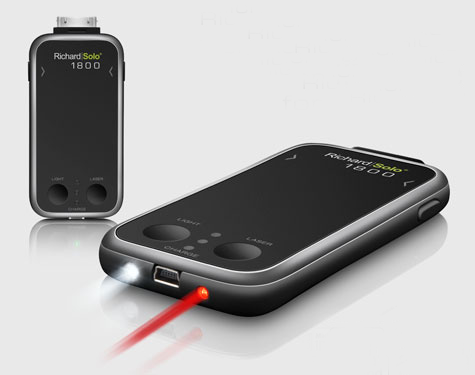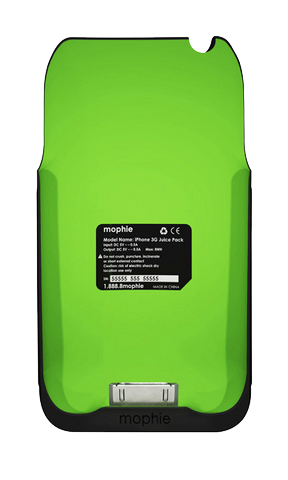RichardSolo 1800 for iPhone
Company: RichardSolo
Price:
$69.95
http://richardsolo.com/

mophie Juice Pack for iPhone 3G
Company: mophie
Price:$99.95
http://www.mophie.com

Ready, Set, Charge!
iPhone 3G’s don’t have great battery life. You can drain the battery in a flash if you work the little box hard by simultaneously talking, iPodding, web surfing, and GPS locating. After all, Apple’s 1400 mAh  (milliamp/hours) battery has only so many electrons to spare.
The original iPhone (non-3G) version has better battery life, as it doesn’t incorporate the juice-sucking 3G and GPS capability. Given that the iPhone is more of a small computer than just a phone, short battery life is understandable, if not welcomed. But you don’t have to tolerate it, if you buy an external battery.
Several companies have products to fill the need for better iPhone 3G battery life. The Weeks Division of MyMac Labs tested two competing iPhone 3G battery packs: the mophie (no, it’s not capitalized) Juice Pack for iPhone, and the RichardSolo (yes, it’s one word) 1800.
Astute MyMac.com readers will remember a previous review of the Juice Pack for the original iPhone. We gave it a favorable review. Can mophie’s follow-on unit for the 3G phone do as well as its predecessor?
RichardSolo 1800
RichardSolo markets several iPhone batteries, and this unit is their newest. It’s a compact battery, measuring only 2″ x 7/16″ x 4 3/8″, with an attractive black plastic finish and silver plastic surrounds. The 1800’s business end is a jack that plugs into the iPhone’s dock adapter. The jack has two reinforcing brackets to stabilize the battery when plugged in. Near the top of the 1800, on both sides of the battery are two squeezable buttons that unlock the battery jack from the dock adapter. These buttons prevent accidental removal of the 1800 from your iPhone.
At the bottom of the 1800’s front side are two buttons; one activates a small light bulb, and the other turns on a red laser pointer. The back side has a On-Off master switch controlling power to the light and laser pointer switches.
The RichardSolo 1800 takes its name from the capacity of its battery: 1800 mAh. This means a fully-charged 1800 can take a discharged iPhone, recharge it, and have juice to spare for another partial slug of juice. How much extra time does this give you? That depends on your usage style. My usage patterns require me to charge my iPhone every day, as it has about 20% left at the end of a typical day’s usage. A typical day for me is 60-90 minutes of phone calls, and lots of email and web surfing, using mostly 3G and only a little WiFi. The iPod gets comparatively little use.
During testing, I attached the 1800 to my iPhone at night, and unplugged it in the morning. I then recharged the 1800 at odd times during the day. RichardSolo states it take about 5 hours to completely top off a fully-discharged 1800. But don’t forget that you won’t fully discharge the 1800 when you recharge off a nearly-dead iPhone. The 1800 ships with several charging cables; the complete kit includes a USB retractable charging cable, a dual USB port car charger, and USA AC adapter. This plethora of chargers was one of my favorite things about the 1800. It’s almost impossible to be in a location where you can’t recharge it.
Three LED status lights keep you informed of the 1800’s charge status.
The 1800 effectively doubled my useful time between recharges. That makes a huge difference in my comfort level, knowing that I’m not going to run dry while out and about.
I found the laser pointer and flashlight to be less than useful. Try as I might, I could not find a use for the laser pointer. I guess I’m not a presentation kind of guy. But if you need it, it’s there.
I also gave it the ol’ college try with the flashlight. I didn’t like carrying the iPhone with the 1800 attached, as it was very awkward to press the flashlight button located at the very end of the battery. Awkward as it may be, the built-in flashlight is far better than using one of the many flashlight application clogging up the iTunes App Store.
This brings out the main drawback to the 1800. The 1800 is not designed to be attached to the iPhone all the time; you plug it in to recharge iPhone, and then disconnect it. You’ve got to keep track of the 1800 and its various chargers. I did try keeping the 1800 attached all day one time, but I never completed the experiment. I became too concerned about over-stressing the dock connector, in spite of the two plastic support clips. You don’t even want to think about repair costs if you snap off the 1800 while it’s attached to the iPhone’s dock connector.
But as a battery pack, the 1800 does a great job.
——————————————
Mophie Juice Pack for iPhone 3G
While the mophie provides the same 1800 mAh of battery power, and roughly the same extension of useful time between recharges, the Juice Pack goes about it in a completely different manner. It’s a battery-cum-sleeve that encases the iPhone, acting as a case. You slide the iPhone into the Juice Pack, and the phone’s dock connector connects with the Juice Pack’s connector located at the inside bottom of the unit. The iPhone is held in place by a firm friction fit. There’s no On-Off switch, and the Juice Pack powers the iPhone until it’s depleted, at which point the iPhone’s battery picks up the load, starting from a full charge.
Unlike the RichardSolo 1800, the Juice Pack has no accessories. It’s a battery, plain and simple. On the back of the Pack are four status lights, activated by a push button to the right of the row of status lights. At the bottom of the Pack is a mini-USB socket to connect with the charging cable. It’s simple and foolproof.
The Juice Pack is well finished, with the exterior made of a nicely grippy material. The Pack is easy to hold securely, and is far more secure than an iPhone with no case or holder. The Juice Pack made the iPhone noticeable bigger and heavier, but not objectionably so. In fact, I felt more comfortable using the iPhone with the Juice Pack than I did using the iPhone with no case at all. I do prefer a belt clip, as I don’t like having to fish the iPhone out of a pocket. Points off for not including one.
With 1800 mAh of battery power, the Mophie roughly doubled my useful life between charges. But I never had to worry about losing it, nor did I worry about something dangling off the iPhone’s dock connector. You can sync your iPhone while its attached to the Juice Pack.
The main disadvantage is price. The Juice Pack is significantly more expensive ($30.00) than the RichardSolo unit, and it’s pushing the limit of being a good value for the money.
Conclusion.
Both the RichardSolo 1800 and the mophie Juice Pack for iPhone 3G deliver the goods. Each one has 1800 mAh of power to keep your iPhone working for twice as long as it normally would without the external battery. The 1800 is a clip-on external battery, so it does not have to get in your way when using the iPhone. But you have to keep track of it, and there’s the worry of stressing the dock connector. You may or may not appreciate the flashlight and laser pointer. It’s quite a bit less expensive than the mophie, and includes more charging accessories.
The mophie Juice Pack for iPhone 3G packs the same 1800 mAh of electrical goodness, in the form of a grippy, easy to hold case the iPhone slides into. You have to tote a bit of extra weight and size, but you’ll never leave it behind, nor worry about the dock connector. It’s simple and elegant.
Both the RichardSolo 1800 and the mophie Juice Pack are fine units. I preferred the mophie.
MyMac.com rating
RichardSolo 1800 4 out of 5
mophie Juice Pack for iPhone 3G 4.5 out of 5
email – MyMac Magazine – Twitter – Advertise – Reviews Archive – Podcast

Leave a Reply
You must be logged in to post a comment.